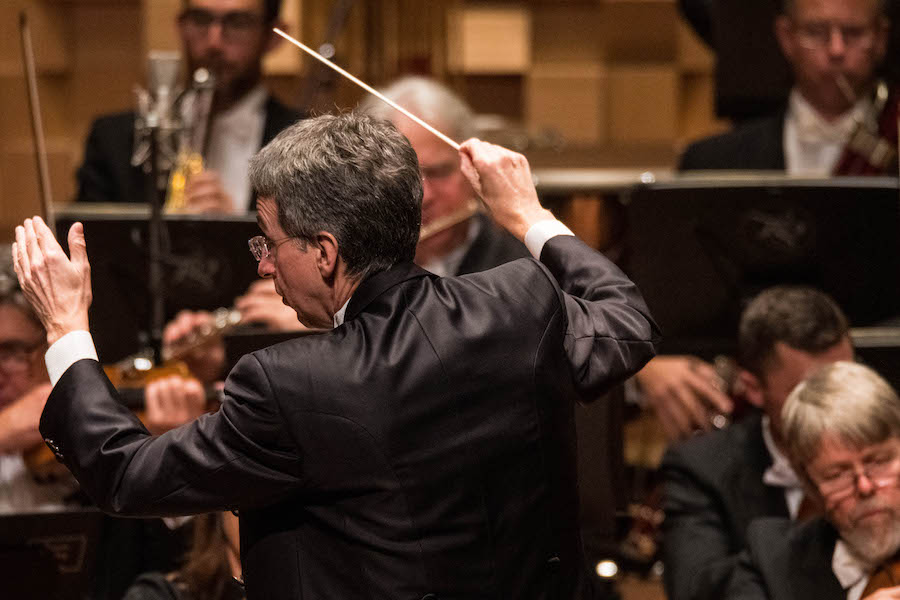This February and March, the Tasmanian Symphony Orchestra has thrown itself into the music of Brahms. From trio to piano concerto, symphony to quartet, it’s all part of the TSO’s Brahmsiana Festival and has been filling various venues across Hobart with a celebration of this composer.
 Eivind Aadland and the Tasmanian Symphony Orchestra. Photo © Alastair Bett
Eivind Aadland and the Tasmanian Symphony Orchestra. Photo © Alastair Bett
I attended the Brahmsiana Symphony No 3 / No 4 event, which took place in the Federation Concert Hall. I was in the mood to hear Brahms’s works, having previously had a chat with some musicians about their appreciation of his chamber music in particular. While their care for the work could also be heard in the symphonies of this Friday night affair, it mainly shone through in the second half – but we’ll get to that soon.
One might find the prospect of back-to-back symphonies to be weighty and perhaps even tiring. But in fact, it’s a far lighter experience than might be expected. As audience members, we knew exactly what we were in for – we could prime our ears for nothing but Brahms, and could also take a rare opportunity to directly compare his third and fourth symphonies with each other. Additionally, there was less fuss between the usual bite-sized pieces found in the first half of concerts, which warm up the audience but require much of the stage elements to be rearranged. For these reasons, I enjoyed the simplicity of the dual symphony structure, and would enjoy seeing it balanced amidst the usual concert programs.
Nevertheless, there were a few too many empty seats at this concert, which was very disappointing and led me to suspect Hobartians may simply have been Brahmsed-out, having already attended some of the other Festival offerings. Before the music began, a string player walked to the front of the stage and warmly told us that Brahms’s works were “great gifts to humanity” that “open our hearts”. (He also told us to turn off our phones and avoid unwrapping lollies.) Then, Symphony No 3 commenced with conductor Eivind Aadland.
Though it may appear a blunt analysis, the first movement Allegro con brio undeniably began with moments of messiness in violins and overpowering brass. It took until the first climax of the movement to build excitement; after which there was an extended rest prior to the start of the second movement Andante. These too-lengthy silent breaks between movements continued throughout the entire event, and greatly detracted from the symphonies’ momentum.
In the Poco allegretto, I could see a clear disconnect between conductor and orchestra – Aadland was precise and expressive in his gestures, but this wasn’t always matched in the players’ responses. Allegro gave a big finish, with its final note being attacked by different players at different times. I’d like to say it’s the fault of the venue’s acoustics, and I suspect it was to a great extent. But then, this assumption also dismisses the players’ control over their performance – and therefore contradicts their far greater performance in the second half.
The Symphony No 4 was excellent: instrumental sections played well individually, which allowed the audience to appreciate their identities as well as Brahms’ orchestration. The second movement Andante Moderato was presented as gently heart-warming and luscious through to intense and angular. The final Allegro energico e passionato gave the concert a big finish – despite a similarly big finish in the first half. Aadland looked exhausted but happy, and still made the effort to show his respect and appreciation to players and the audience, rather than simply leaving the stage. All conductors should take a leaf out of his score, so to speak.
The concert felt quite short, which may be why Aadland made a playful return for the encore – Brahms’ Hungarian Dance No 5. He conducted without a score. After it, people cheered louder than they usually do in Hobart – not just because of the familiarity of this beloved little piece, but because it was the best-performed work on the program.











Comments
Log in to join the conversation.